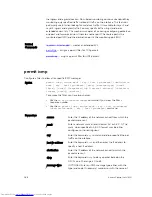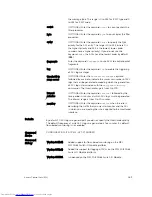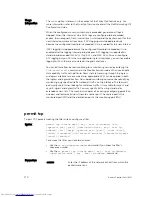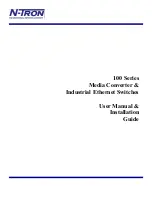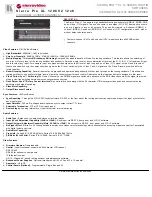
deny (for Extended IP ACLs)
Configure a filter that drops IP packets meeting the filter criteria.
Syntax
deny {ip |
ip-protocol-number
} {
source mask
| any | host
ip-
address
} {
destination
mask | any | host
ip-address
} [count
[byte]] [dscp
value
] [order] [monitor] [fragments] [log
[interval
minutes
] [threshold-in-msgs [count]] [monitor]
To remove this filter, you have two choices:
• Use the
no seq
sequence-number
command if you know the filter’s
sequence number.
• Use the
no deny {ip |
ip-protocol-number
} {
source mask
| any |
host
ip-address
} {
destination mask
| any | host
ip-address
}
command.
Parameters
source
Enter the IP address of the network or host from which the
packets were sent.
mask
Enter a network mask in /prefix format (/x) or A.B.C.D. The
mask, when specified in A.B.C.D format, may be either
contiguous or non-contiguous.
any
Enter the keyword
any
to specify that all routes are subject
to the filter.
host
ip-address
Enter the keyword
host
then the IP address to specify a host
IP address.
destination
Enter the IP address of the network or host to which the
packets are sent.
count
(OPTIONAL) Enter the keyword
count
to count packets
processed by the filter.
byte
(OPTIONAL) Enter the keyword
byte
to count bytes
processed by the filter.
order
(OPTIONAL) Enter the keyword
order
to specify the QoS
priority for the ACL entry. The range is from 0 to 254 (where
0 is the highest priority and 254 is the lowest; lower order
numbers have a higher priority) If you did not use the
keyword
order
, the ACLs have the lowest order by default
(255).
monitor
OPTIONAL) Enter the keyword
monitor
when the rule is
describing the traffic that you want to monitor and the ACL
in which you are creating the rule is applied to the monitored
interface.
fragments
Enter the keyword
fragments
to use ACLs to control packet
fragments.
log
(OPTIONAL) Enter the keyword
log
to enable the triggering
of ACL log messages.
Access Control Lists (ACL)
155




























